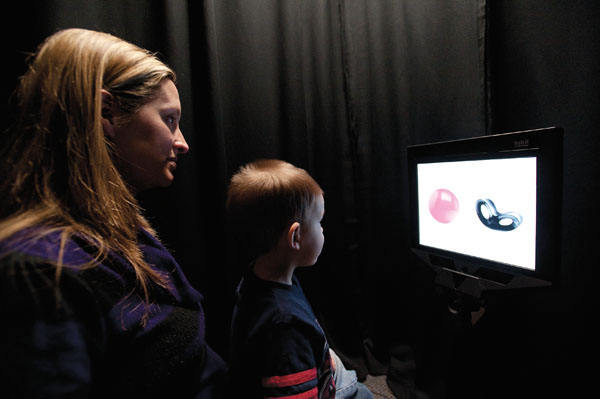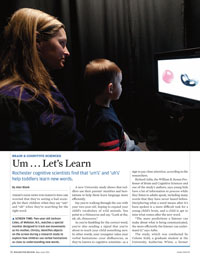In Review
 SCREEN TIME: Two-year-old Jackson Coles, of Webster, N.Y., watches a special monitor designed to track eye movements as his
mother, Christy, identifies objects on the screen during a research study to explore how children use verbal hesitations as
clues to understanding new words. (Photo: Adam Fenster)
SCREEN TIME: Two-year-old Jackson Coles, of Webster, N.Y., watches a special monitor designed to track eye movements as his
mother, Christy, identifies objects on the screen during a research study to explore how children use verbal hesitations as
clues to understanding new words. (Photo: Adam Fenster)There’s good news for parents who are worried that they’re setting a bad example for their children when they say “um” and “uh” when they’re searching for the right word.
A new University study shows that toddlers use their parents’ stumbles and hesitations to help them learn language more efficiently.
Say you’re walking through the zoo with your two-year-old, hoping to expand your child’s vocabulary of wild animals. You point to a rhinoceros and say, “Look at the, uh, uh, rhinoceros.”
As you’re fumbling for the correct word, you’re also sending a signal that you’re about to teach your child something new. In other words, your youngster takes your verbal hesitations—your disfluencies, as they’re known to cognitive scientists—as a sign to pay close attention, according to the researchers.
Richard Aslin, the William R. Kenan Professor of Brain and Cognitive Sciences and one of the study’s authors, says young kids have a lot of information to process while they listen to adults speak, including many words that they have never heard before. Deciphering what a word means after it’s been spoken is a more difficult task for a young child’s brain, and a child is apt to miss what comes after the new word.
“The more predictions a listener can make about what is being communicated, the more efficiently the listener can understand it,” says Aslin.
The study, which was conducted by Celeste Kidd, a graduate student at the University, Katherine White, a former postdoctoral fellow at Rochester who is now at the University of Waterloo, and Aslin, was published online in the journal Developmental Science.
The researchers studied three groups of children between the ages of 18 and 30 months. Each child sat on his or her parent’s lap in front of a monitor with an eye-tracking device. Two images appeared on the screen: one image of a familiar item (like a ball or a book) and one made-up image with a made-up name (like a “dax” or a “gorp”). A recorded voice talked about the objects with simple sentences. When the voice stumbled and said “Look at the, uh . . . ” the child instinctively looked at the made-up image much more often—almost 70 percent of the time—than the familiar image.
“We’re not advocating that parents add disfluencies to their speech, but I think it’s nice for them to know that using these verbal pauses are OK—the “uh’s” and “um’s” are informative,” says Kidd, the study’s lead author.
In the study, the effect was only significant in children older than two years. The younger children, the researchers reasoned, had not yet learned the fact that disfluencies tend to precede novel or unknown words.
When kids are between the ages of two and three, they usually are at a developmental stage where they can construct rudimentary sentences consisting of about two to four words. And they typically have a vocabulary of a few hundred words.
The study builds on earlier research by Jennifer Arnold, a scientist at the University of North Carolina and a former postdoctoral fellow at Rochester, which found that adults also can use “um’s” and “uh’s” to their advantage in understanding language. Additionally, work by Anne Fernald at Stanford University has shown that it’s not the quality but the quantity of speech that a child is exposed to that’s most important for learning.
Alan Blank writes about the sciences for University Communications.

